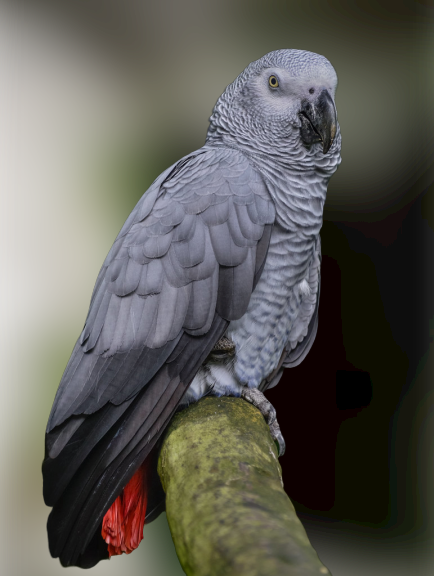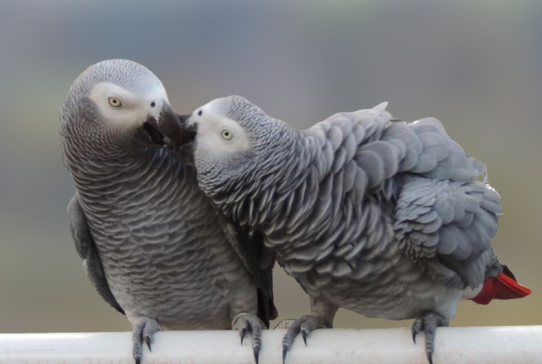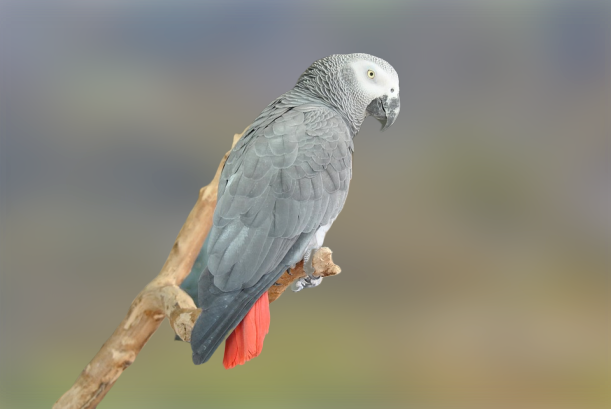African grey parrot(talking parrot)
The African gray parrot is one of the most capable winged
animals that speak/reflect on the planet, giving it significant notoriety
among feathered creatures. The people who are not exclusively flying creatures
adore this passionate winged animal, it is also one of the most unmistakable
species for the beginners of feathered creatures: everyone knows the African
gray parrot. This parrot is one of the most seasoned psittacine species guarded
by people, with recordings of winged animals dating back to scriptural
occasions. The understated magnificence and a simple intelligent mood are what
keep this parrot at the top of the limelight. From the beginning, the African
gray is a creature of medium-sized gray feathers, with a dusty appearance,
almost like a pigeon - however, more deeply, the exam reveals a splendid red
tail, expert orange eyes and an incredible scalloped example to its plumage.
The African gray parrots, for the most part, occupy savannahs, beach mangroves,
forests and woodland glades in their western and central Africa .
Despite the fact that the largest of the gray African subspecies is alluding to
the African gray of the Congo ,
this feathered creature does indeed have a much broader range in Africa,
including the southeastern Ivory Coast ,
Kenya and Tanzania. Timneh's African Gray is found in a small area along the western edge of the Ivory Coast and through southern Guinea
Care and Feeding
There is a motivation behind why African gray is
regularly seen as the feathered creature in the publication for parrot
understanding - not only does this winged creature lean-to store huge jargon,
but African grays also exhibit physical fitness to perceive the meaning of
words and expressions. African grays need many toys to test their knowledge, such
as scrounging and baffle toys. Nutri-Berries by Lafeber The company is ideal
for research. This total nourishment mixes a parity of different cereals,
seeds, and supplements in the state of a berry. Since cereals and seeds are
generally whole and framed in the shape of berries, it urges African grays to
hold, snack and even play with Nutri berries. This copies the rummaging that
African grays do in nature. African grays seem to be particularly influenced by
pressure and turmoil in their conditions and can be more comforted by placing a
corner of the border against a divider rather than in a room. African gray
parrots are progressively prone to the inadequacy of nutrient A/beta-carotene
and, on this line, they profit by eating vegetables rich in beta-carotene, for
example, cooked sweet potatoes and cabbage. The nutritional insufficiency of D
is another concern, particularly for grays in a horrible food routine. Offering
a reasonable diet based on pellets, such as Nutri-Berries, for the primary diet
of an African gray, it counteracts nutritional and mineral inadequacies. A gray
that devours a pellet diet, does not require improvements in nutrients added to
its livelihood.
Character and Behavior
Most feathered creature managers accept that solitary an
accomplished winged animal lover should keep a grey. They are unpredictable
parrots, exceptionally touchy, and all-around requesting. They are additionally
beguiling and splendid, yet this match of affectability and minds can prompt
conduct issues. They are animals of propensity, and even a little change in
routine can make a delicate grey troubled. They are inclined to culling and
biting their quills, among other unfortunate propensities. Narratively, the TAG
has a hardier disposition and might be better for families with many
individuals going back and forth. The CAG lean towards somewhat less confusion.
African greys are great talking parrots that need a ton of hands-on
schedule, in any case, they aren't "cuddle bugs." They will endure
some head-scratching and a tad of petting, yet they don't acknowledge
exceptional physical contact, however, a few people wouldn't fret a touch of
cuddling. Each feathered creature has individual tastes and inclinations. A
grey can likewise turn into a "one individual fowl," regardless of
whether each individual from the family unit associates with it from the
earliest starting point.
Discourse and Sound
A significant part of Grey's intrigue originates from
its talking capacity. It is among the best talkers in the parrot family, ready
to rehash words and expressions in the wake of hearing them just on more than one
occasion. This winged creature arrives at full talking capacity around time
of age, and most people become proficient imitates a lot prior.
Not exclusively will a grey build up an extraordinary
jargon, inquire about has demonstrated that this species can come to comprehend
what it's an expression. The most well known CAG, Alex, and his partner, Dr. Irene
Pepperberg might be the explanation behind the prevalence of this species, and
positively for its prominent. Alex and Dr. Pepperberg cooperated for a long
time at Brandeis University
Be that as it may, in light of the fact that greys are
brilliant and may talk as opposed to shouting, it's a slip-up to accept that they
aren't loud. They aren't as uproarious or determined as a portion of the South
American species, yet they will learn family sounds and use them energetically
to the daunt of gatekeepers. Envision the microwave blaring unremittingly, or a
cellphone ringing frantically without the advantage of turning it off.
Wellbeing and Common Conditions
African greys are particularly helpless to quill picking,
calcium insufficiency, nutrient An and nutrient D lack, respiratory
contamination, psittacosis and psittacine snout and plume infection (PBFD).
Get an African Grey Parrot
There are two particular subspecies of the African grey
parrot: the Congo African grey (Psittacus erithacus), additionally called the
red-followed grey and the CAG, and the Timneh African grey (Psittacus erithacus
timneh), or TAG. Frequently the huge Congo
greys were "Cameroons" since they were once thought to be a
subspecies from that region, however in truth, the bigger feathered creatures
were pirated into Cameroon
The CAG is increasingly prominent of the two subspecies,
being bigger and having a red tail and dark nose. The TAG is littler with a
lot darker grey body, about grey, with a horn-shaded mouth, and its tail
extends in shading from maroon to dull grey or dark. The two winged creatures
make similarly fine friends.
African grey parrots are bound to be accessible in
avian-forte stores or from a fowl raiser. African greys are additionally once
in a while accessible for appropriation from winged creature salvage/selection
associations.




